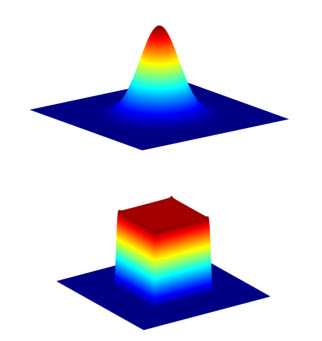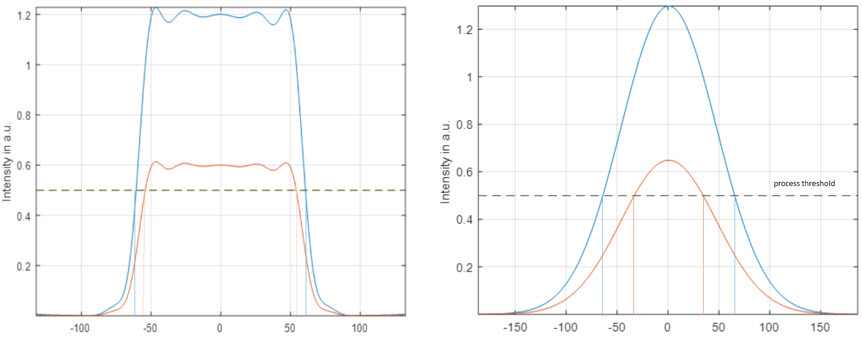What is a Flat Top Laser Beam?
A Flat Top Laser beam is a beam whose intensity profile is uniform inside a certain beam shape, with a sharp drop off at the edges. Unlike the Gaussian beam profile of most laser beams, where the width of the Gaussian spot (above a process threshold) is directly proportional to the energy, a flat Top laser beam profile is characterized by having almost no dependence between energy and spot size above the Threshold. This makes a flat top beam profile highly desirable in many industrial laser applications.

Where are flat top beam profiles used?
Many laser applications utilize a flat top beam profile to enhance performance and enable sharp edges of the treated material. Such applications include:
- Laser Lift-off and debonding- a laser process used in the flat panel industry, in laser debonding a think wafer needs to be disconnected from a thicker carrier wafer. Often done by employing intense UV lasers, this process requires extremely intensity high uniformity and sharp treated edges. Both line top hats and square/rectangle flat top laser beam shapers are used for such processes, depending on the system configuration.
- Metallic interconnect scribing- Often used in the solar cells industry, Laser flat top beam profiles are employed to achieve sharp borders of the scribed lines, ensuring consistent performance of the interconnects or electrodes.
- Wafer inspection- flat top beam profiles are critical in wafer inspection applications, where uniform illumination enables reliable detection of defects. Often, flat top line shaped beams are used in such applications.
- Precise laser welding- often when welding sensitive material such a polymers, or when sealing battery packs by laser welding, a flat top laser beam employed to achieve improved weld strength and a better contact angle.
The advantages of using flat top laser beams
Using a top hat beam shape has the following advantages:
- For a given process threshold energy, a flat top spot will remain almost the same size even when pulse energy is increased. This enables wide process latitude when working with the same laser machine on different materials/ thicknesses.
- The laser energy is utilized in the most optimal way- less energy is wasted below the process threshold.
- The heat affected zone (HAZ) is reduced, as less energy is needed to get the same process result. This results in sharp, crisp edges of the processed area.
How can a flat top laser beam profile be achieved?
One of the best methods to achieve flat top laser beams in industrial applications is by utilizing a diffractive flat top beam shaper. This is a special diffractive optical element that, for a given design wavelength creates a free-form phase profile that shapes the laser into a flat top beam at the far-field (typically an external lens focal plane).
This single element solution can be tailored to provide a specific shape for a given single mode input beam with a pre-determined beam diameter. Shapes can be round, square, rectangular, line or even more complex distributions such as several rectangles. Other types of flat top beam shapers are refractive free-forms shapers, often employed in less demanding shaping applications with higher divergence angles, and flat top diffusers, used with highly multimode beams.
The advantages of diffractive flat top beam shapers
The main advantages of diffractive Top Hat beam shapers compared to refractive ones are:
- Diffractive Top Hat shapers have absolute angular accuracy, enabling small shaped flat tops of down to 1.5 diffraction limits, while refractive Top Hat shapers typically have some tolerance on shaping angle due to production processes.
- Diffractive Stable Top Hat elements have a significantly sharper shape edges compared to refractive Top Hats.
- Diffractive flat top laser beam shapers are often thin windows, while refractive typically have some thickness of atr least 3mm for the accurate processing to the required freeform. This makes diffractive beam shapers better for ultra-short pulsed laser shaping, as the temporal dispersion is minimal.
- Diffractive flat top shapers can be integrated into standard F-theta and Scanner setups used in industrial laser machines with no difficulty, due to their small size, their ability to shape accurately at low angles (so that there is little to no clipping) and the fact they have almost zero optical power, enabling them to work perfectly at the focal field of the F-theta lens.

Holo/Or has an installation guide and application notes, aimed at facilitating diffractive Top Hat use.
TL;DR - Q&A summary
What is a Flat Top Laser beam?
A flat top laser beam is a beam whose intensity profile is uniform inside a given r shape, with a sharp drop-off outside this shape.
Why is a flat top laser beam better than a Gaussian profile for industrial laser applications?
A flat laser beam has many advantages over a regular Gaussian-like profile, including the fact that the processed area does not change with increased laser energy, and the better utilization of laser energy enabling use of less energetic pulses to achieve the same effect, reducing HAZ and improving processing quality.
How can one generate a flat top beam profile
For Single mode, coherent laser shaping, diffractive flat top beam shapers are often the preferred solution. For less coherent lasers, flat top diffusers are optimal.
What are the advantages of Diffractive flat Top beam shapers?
Diffractive Top Hat shapers offer near absolute angular accuracy, enabling shaping to dimensions of a few times the diffraction limited spot size. Such small shapes are often used in precise laser material processing. Furthermore, these diffractive shapers are compatible with standard F-theta and scanner setups often employed in such setups.

